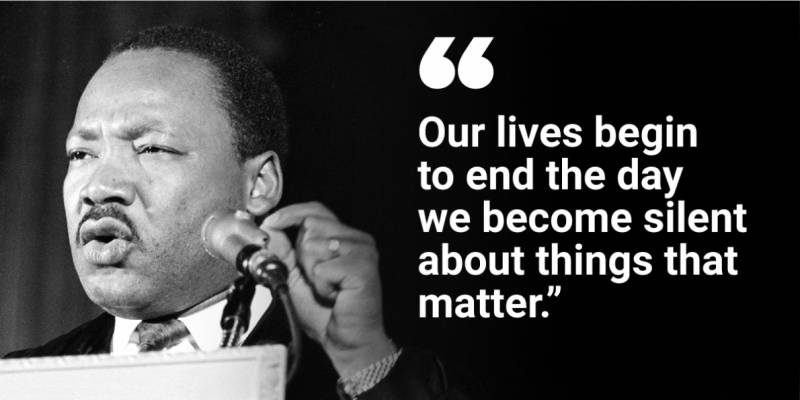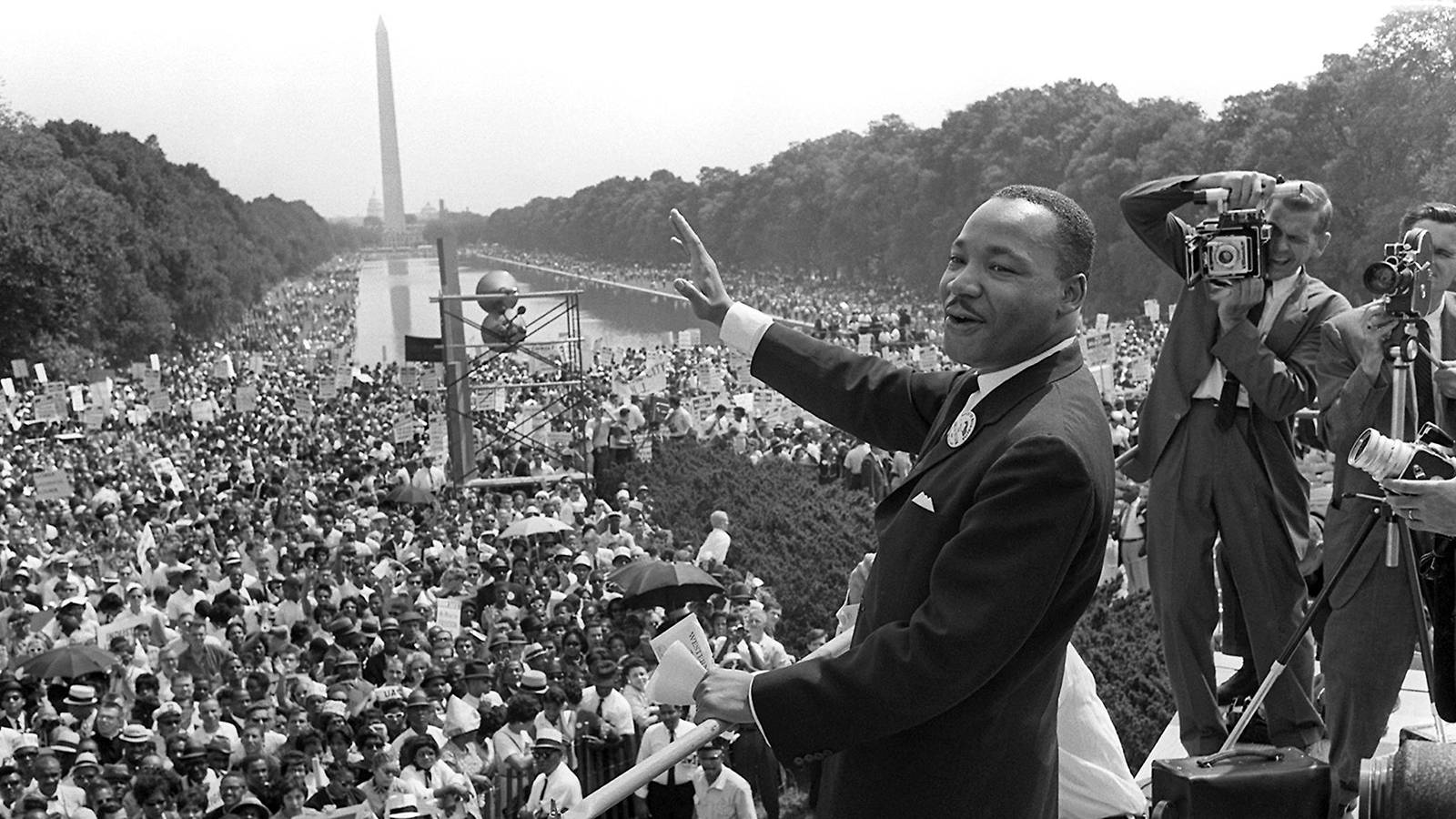Happy new year, Champaign County.
Now that we have rested up from the holidays, it’s back to school, work, and another of Champaign County’s traditions: an assortment of Dr. Martin Luther King Jr. celebrations. One of this year’s countywide programs, hosted at Vineyard Church on Friday, January 12, promises “… a presentation of awards and a keynote speaker. Awards at the Celebration will honor Champaign County individuals and organizations that have made outstanding contributions, consistent with the philosophy and mission of Dr. King in community service, humanitarian work and the promotion of equal rights.” Other events will be occurring throughout the community as well.
If my memory serves me correctly, local custom dictates that we herd ourselves into one of our grand edifices, hug and greet the other King acolytes, and extol the virtues of Martin Luther King’s legacy via thoughtful reflections and the arts.
Typically, we view Dr. King’s face in profile while snippets of his words wash over us, and we usually leave feeling good about ourselves for attending said event: civic duty satisfied.
So, while I pondered our typical King celebrations, my mind kept tossing around two phrases: “Chaos or Community” and “Where Do We Go From Here?” Given that 2017 ended with public meetings, presented reports, and “staged racial justice,” the two phrases seemed particularly pertinent.
Thus, I decided to review that particular King text — Where Do We Go From Here: Chaos or Community (1967) — to see what King would say to me fifty years later. I couldn’t have imagined how relevant the text would be to our own Champaign County realities.
Early in the book, after chronicling civil rights gains made by activists in local communities, Dr. King stops to take stock of the state of the Negro in 1967:
Now, in order to answer the question, “Where do we go from here?” which is our theme, we must first honestly recognize where we are now. […] Of the good things in life, the Negro has approximately one half those of whites. Of the bad things of life, he has twice those of whites.
Thus, half of all Negroes live in substandard housing. And Negroes have half the income of whites. When we turn to the negative experiences of life, the Negro has a double share: There are twice as many unemployed; the rate of infant mortality among Negroes is double that of whites…
Reading 1967 King felt eerily contemporary. I wondered why King’s sentiment felt so familiar. Then I realized that we can examine…
- The Champaign County Board Racial Justice Task Force Report and Recommendations Developed to Reduce Racial Disparities in the Champaign County Criminal Justice System
- The Urbana Police Department: 2017 Traffic Stop Update
- CU Fresh Start Deterrence Initiative Phase 1 Evaluation
… and find that for many African Americans, Champaign County today resembles King’s America in 1967 in far too many areas!

Despite the fact that African Americans make up only 13 percent of the Champaign County population of 208,149 according to the July 2016 US Census Quick Facts, African Americans exceed that percentage in many categories of local life:
According to the Urbana Police Department: 2017 Traffic Stop Update findings reported in the News Gazette, Black drivers were 66 percent more likely to be stopped by Urbana police. Police crime analyst Melissa Haynes said that percentage is “consistently higher” than for other racial groups. It was up from 62 percent for the period covering the first 6 months of this year.
According to the CU Fresh Start Planning Phase Assessment prepared by Institution Builders, Inc., of the 535 gun-related incidents that occurred in Champaign, Urbana, and nearby villages and towns, 2013–2017, 73.21 percent of offenders involved in gun-related incidents were Black, and 78.86 percent of the victims in gun-related incidents were Black. Furthermore, the average age of gun-related incident arrestees and offenders was 25; the average age of gun-related incident victims was 34. Most arrestees, offenders, and victims were identified as Black and as male (p. 16).
The Racial Justice Task Force Champaign, IL Report and Recommendations Developed to Reduce Racial Disparities in the Champaign County Criminal-Justice System provides the most disturbing reporting on African-American interactions with the criminal justice system, law enforcement in local schools, and those seeking to secure housing.
African Americans in Champaign County are four times more likely to be arrested than Whites (p. 27).
African-American population in jail in Champaign County ranges anywhere from four to six times the percentage of the population (p. 31): “It can be safely said that people incarcerated in the county jail are not only disproportionately African American but also with low if any incomes before their arrest” (p. 32).
In Champaign County, an African American is more than twice as likely as a White person to live in poverty. According to the US Census Bureau 2015 estimates for Champaign County, 41.5 percent of African Americans have incomes below the poverty level, compared to 17.2 percent of White people (p. 36).
There is a disparity between the extensive data collected in Champaign-Urbana schools versus data collected on student arrests in St. Joseph Ogden and Prairieview-Ogden schools.
While the report sites in granular detail infractions committed by African-American students in particular in Champaign and Urbana schools, citing 357 arrests of African-American students from 2006–2016 (of total 417 at-school arrests), Sheriff Dan Walsh states that “his department doesn’t keep detailed statistics of student arrests, but was able to identify only 18 arrests in Tolono and St. Joseph Ogden combined in the last 10 years” (pp. 47–48).
Additionally, Champaign County, the tenth-largest county in Illinois via populations, had the fifth-highest youth detention admission rate in Illinois, per capita, for African-American youth compared to all other counties in the state (p. 50).
So what is the point of gathering to celebrate how far only a worthy few have come? If we believe the findings documented in these city and county reports, African Americans on the whole continue to live imperiled lives in Champaign County.
What does it mean for the approximately 27,059 African Americans to live in a community where they are over-surveilled, targeted, un- and underemployed, under-resourced, overwhelmingly perpetrators and victims of local gun violence, and forced into the school-to-prison pipeline at earlier and earlier ages?
African Americans, why are we willing to live in Champaign County in this way?
Furthermore, what does it mean for the 87 percent of the population of White, Asian, Latino, Native, and multiracial community members that African Americans live this way? Why are we willing to live among each other in this way?
Who benefits most from abiding such disparities? Might there be another way for us to live together?
These are the questions I wish we took time to consider deeply about ourselves and worked to resolve during this season when we gather to remember King.
Nicole Anderson Cobb, PhD, is a four-time UIUC alum and an educator, writer, and anti-violence activist. She lives in Champaign with her family.








